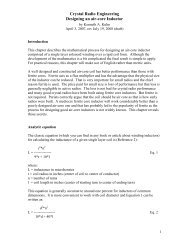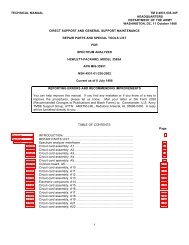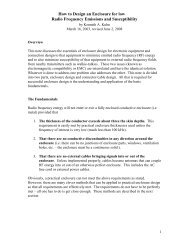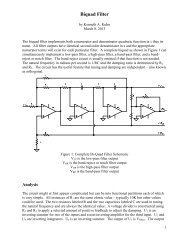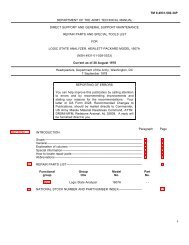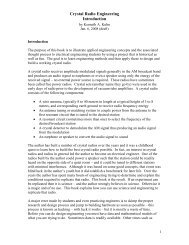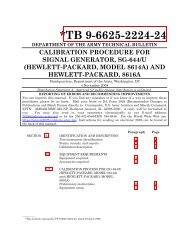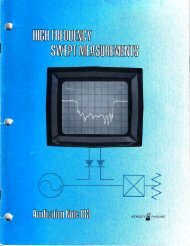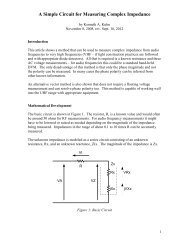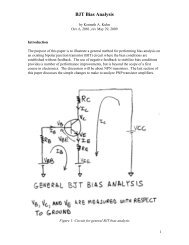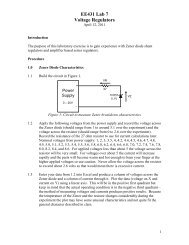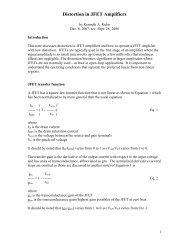Crystal Radio Engineering Headphones - Ken Kuhn's
Crystal Radio Engineering Headphones - Ken Kuhn's
Crystal Radio Engineering Headphones - Ken Kuhn's
You also want an ePaper? Increase the reach of your titles
YUMPU automatically turns print PDFs into web optimized ePapers that Google loves.
<strong>Crystal</strong> <strong>Radio</strong> <strong>Engineering</strong><br />
<strong>Headphones</strong><br />
by <strong>Ken</strong>neth A. Kuhn<br />
March 1, 2008, (draft)<br />
Introduction<br />
<strong>Headphones</strong> are made using small electrical to acoustical transducers that are located<br />
very close to the human ear so that very little electrical power is required for hearing a<br />
signal. With sensitive (i.e. high efficiency) headphones it is possible to hear audio<br />
signals in the nanowatt range! A milliwatt is a huge amount of power and makes a very<br />
loud signal.<br />
Headphone types<br />
There are three basic types of headphones as described below<br />
Magnetic These were the first headphones ever built and were popular for many<br />
years although modern headphones work better and have replaced them.<br />
Magnetic headphones are constructed by winding many turns of fine wire to form<br />
a coil around an iron core that includes a permanent magnet. A thin iron plate<br />
which makes the sound is held in place by the magnetic field. The center portion<br />
of the thin plate is pulled by the magnetism. As an audio (i.e. AC) current is<br />
passed through the coil the magnetic field increases or decreases in response. The<br />
variation in the magnetic field modulates the force of attraction of the iron plate<br />
which then moves slightly thus making a sound. Magnetic headphones generally<br />
have an impedance in the 2,000 to 20,000 ohm range. The impedance is not the<br />
DC resistance but is related to the inductance of the winding on the coil and the<br />
acoustical reaction of the iron plate. Some magnetic headphones are quite<br />
sensitive but others are only fair. Any old headphone set you find could vary<br />
considerably in impedance and sensitivity–you would have to make your own<br />
measurements with laboratory equipment to truly know what you have. For<br />
nostalgia there is an attraction to using magnetic headphones (if you can find<br />
them–they are old and rare now). However, modern speaker phones generally<br />
are more sensitive and work better.<br />
<strong>Crystal</strong> These are based on the piezoelectric effect (piezo means force or<br />
pressure). A crystal physically expands or contracts in response to an electrical<br />
voltage applied across it. If the electrical voltage represents an audio signal then<br />
sound can be heard coming from the crystal. The process also works in reverse<br />
and the device is known as crystal microphone. Sound pressure causes the crystal<br />
to expand or contract which produces a voltage in proportion. <strong>Crystal</strong> earphones<br />
used to be very popular but are now rare as modern earphones work much better.<br />
<strong>Crystal</strong> earphones can be damaged by mechanical shock (such as dropping) and<br />
humidity. The sensitivity varies a lot–some are insensitive, others are fairly<br />
sensitive. <strong>Crystal</strong> earphones are high impedance (typically much greater than<br />
1
<strong>Crystal</strong> <strong>Radio</strong> <strong>Engineering</strong><br />
<strong>Headphones</strong><br />
50,000 ohms) devices and are ideal for use with crystal radios. DC voltages<br />
should not be applied so a coupling capacitor (typically in the 0.1 uF range)<br />
should be used to block the DC detected voltage from the rectifier diode. A<br />
resistor (often around 50,000 to 100,000 ohms) is placed across the output of the<br />
rectifier diode to ground to provide a required DC complete circuit.<br />
Speaker These headphones are built using a tiny speaker located close to the ear.<br />
The interest in using these with modern battery powered equipment has led to the<br />
development of units that require only a very small electrical power (on the order<br />
of a milliwatt) to produce a loud sound. The typical impedance of these units<br />
ranges from around 30 to 150 ohms so some kind of transformer is always<br />
required to match into the much higher detector impedance (typically tens of<br />
thousands of ohms) of the crystal radio. If the left and right earpieces are<br />
connected in parallel then the impedance is halved. The impedance would be<br />
doubled if the units are connected in series. There is a slight issue with connecting<br />
the phones in series and that is that the phase is inverted from ear to ear–this<br />
really only matters for low audio frequencies. This would not be desirable from a<br />
high-fidelity standpoint but probably makes little, if any difference to most people<br />
particularly in a crystal radio setting as it is a thrill to hear anything at all.<br />
Sensitivity<br />
In modern society people are accustomed to high sound levels. People accustomed to<br />
this initially have difficulty in acclimating themselves to hear faint sounds. With practice<br />
and concentration, remarkably low sound levels can be heard. This is necessary to be<br />
able to use a crystal radio. Once you have adapted yourself to listen to weak signals the<br />
noisy world we live in will become very obvious.<br />
It is very important to use headphones that are highly efficient. Audio quality is of no<br />
concern although just about all modern headphones have fine audio quality. A small<br />
amount of power produces a high volume in even inefficient headphones so few people<br />
care about efficiency and that data is rare. When you can find such data it is typically<br />
given in terms of dBa for one milliwatt with typical values ranging from the seventies<br />
(low efficiency) to over one hundred (high efficiency) dBa for one milliwatt. It does not<br />
make any sense to measure efficiency for this case in percent. What matters is how much<br />
acoustical power can be delivered to the ears for as little electrical power as possible–<br />
that is what we need for a crystal radio. In the case of crystal radios the amount of<br />
available audio power is incredibly small–perhaps microwatts or less so highly efficient<br />
headphones are a necessity.<br />
We should review some facts about acoustical power and decibels. Decibels always<br />
represent a power ratio. We might derive the value from a voltage or current ratio but it<br />
is always power that matters. When we speak of a sound level of 80 dBa, then we are<br />
referring to an acoustical power density relative to the zero dBa reference level which has<br />
been established at 1 pW per square meter (note: some sources state 2 pW). Acoustical<br />
2
<strong>Crystal</strong> <strong>Radio</strong> <strong>Engineering</strong><br />
<strong>Headphones</strong><br />
levels are very commonly measured in dBa but unfortunately, the ‘a’ subscript which<br />
refers to the particular acoustic 0 dB reference level is often dropped. There is no such<br />
thing as absolute dB as the language often sounds like. The following table provides<br />
some examples. The headphones referenced are rated for 90 dBa / mW. This does not<br />
mean 90 dBa per milliwatt but that a sound pressure level of 90 dBa is produced by one<br />
milliwatt of electrical power. The sound pressure level produced by ten milliwatts would<br />
be 100 dBa. It is hard to hear sound pressure levels less than about 30 dBa because other<br />
low level noises are in that order of magnitude and mask the sound. Table 1 indicates<br />
that with ordinary headphones one should be able to detect an audio signal in the 1 nW<br />
range. That would barely be distinguishable from background noise in the room.<br />
However, a one-hundred nW level should readily be heard in the headphones.<br />
dBa Power density <strong>Headphones</strong> Examples<br />
0 1 pW/m2 accepted threshold of human hearing<br />
10 10 pW/m2<br />
20 100 pW/m2<br />
30 1 nW/m2 1 nW quiet room (background noise level)<br />
40 10 nW/m2 10 nW very quiet whisper conversation<br />
50 100 nW/m2 100 nW<br />
60 1 uW/m2 1 uW quiet conversation<br />
70 10 uW/m2 10 uW typical office and normal conversation<br />
80 100 uW/m2 100 uW moderately loud radio<br />
90 1 mW/m2 1 mW loud radio<br />
100 10 mW/m2 10 mW very loud radio; many complaints likely<br />
110 100 mW/m2 100 mW<br />
120 1 W/m2 1 W extremely loud dance club; threshold of pain<br />
Table 1: Acoustical data (headphones are 90 dBa for 1 mW)<br />
3



